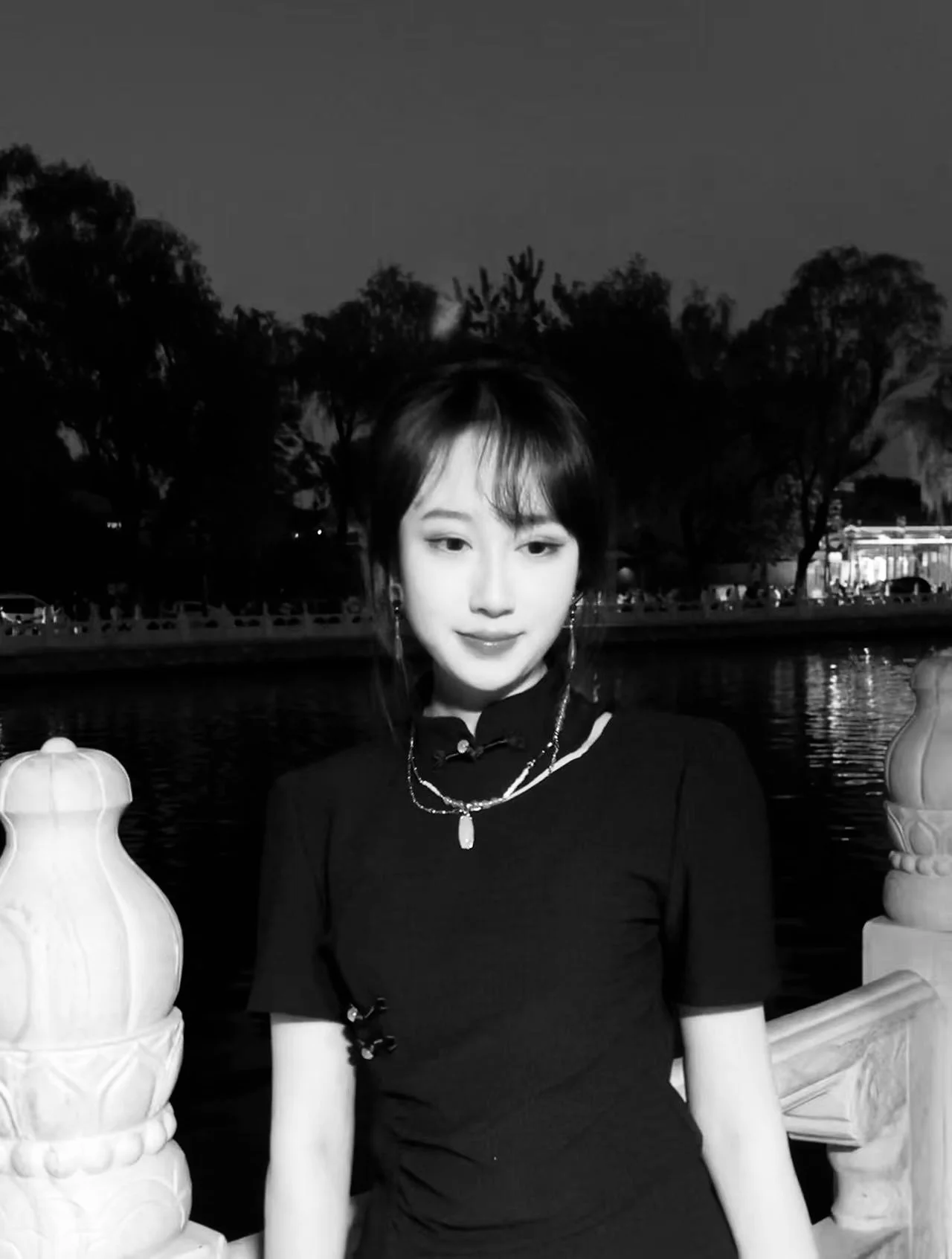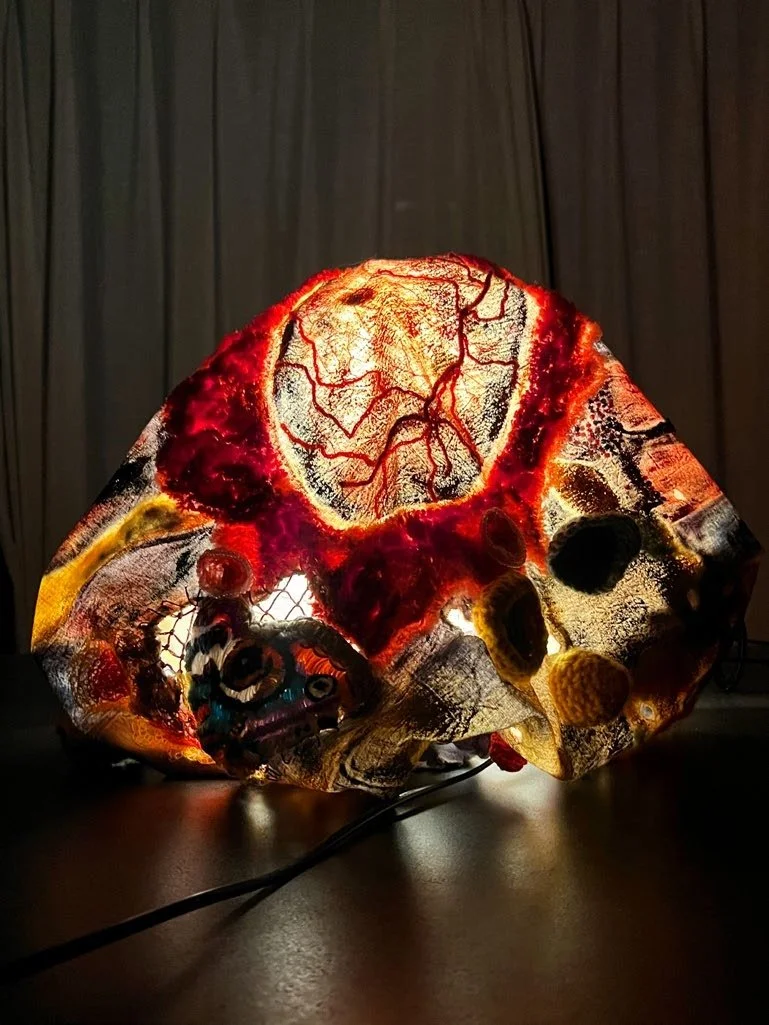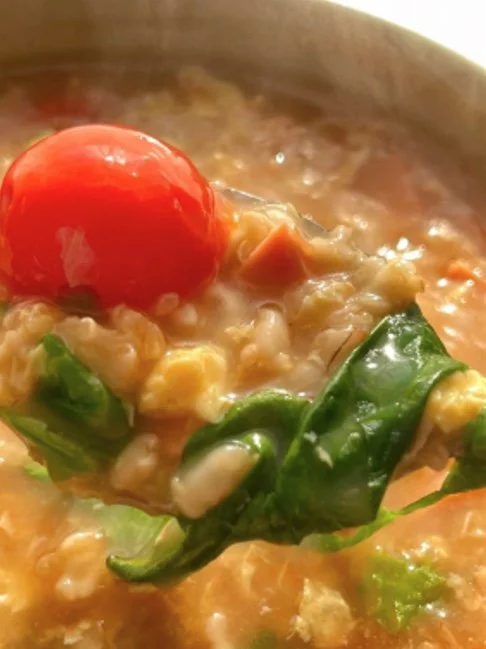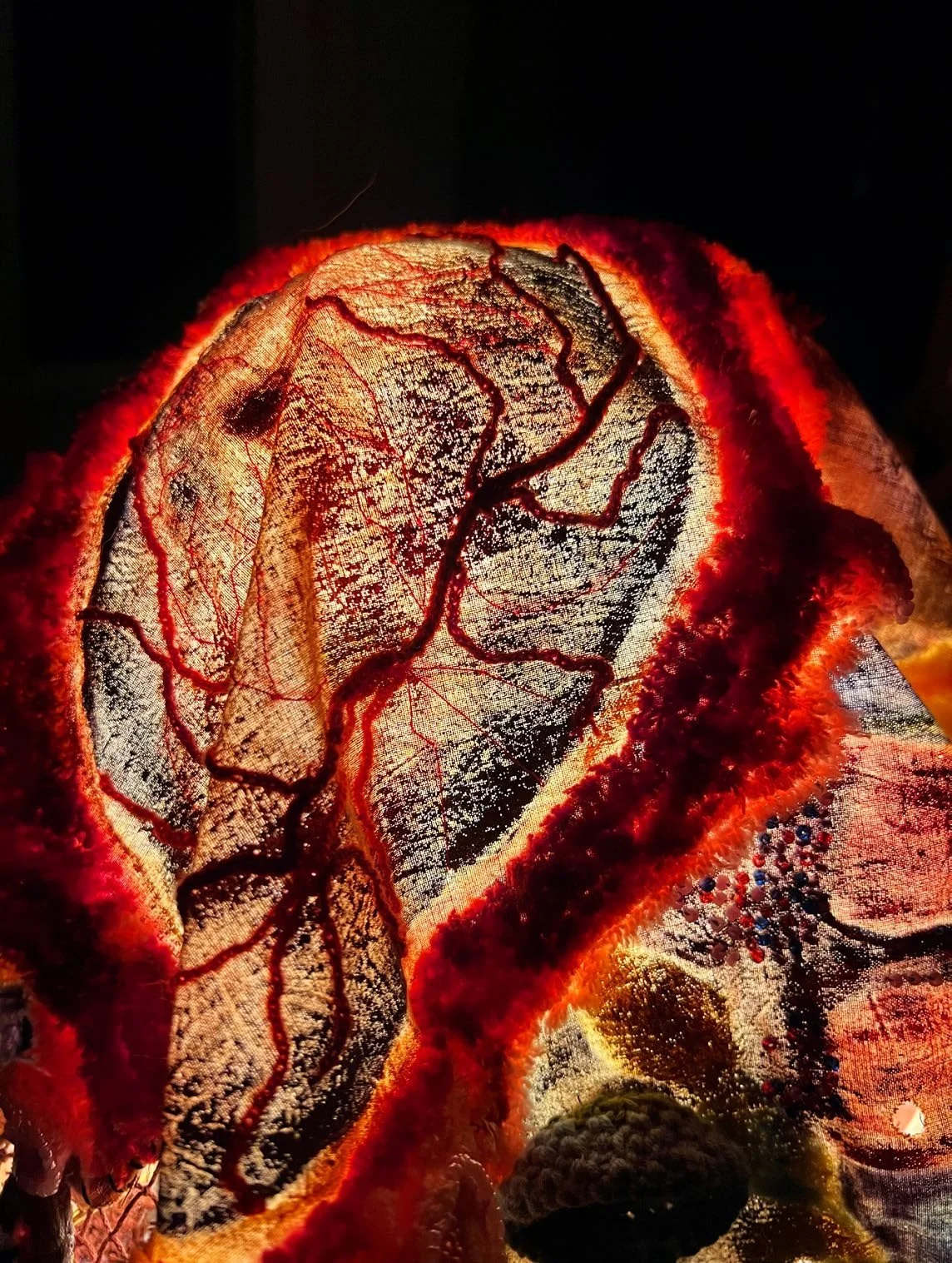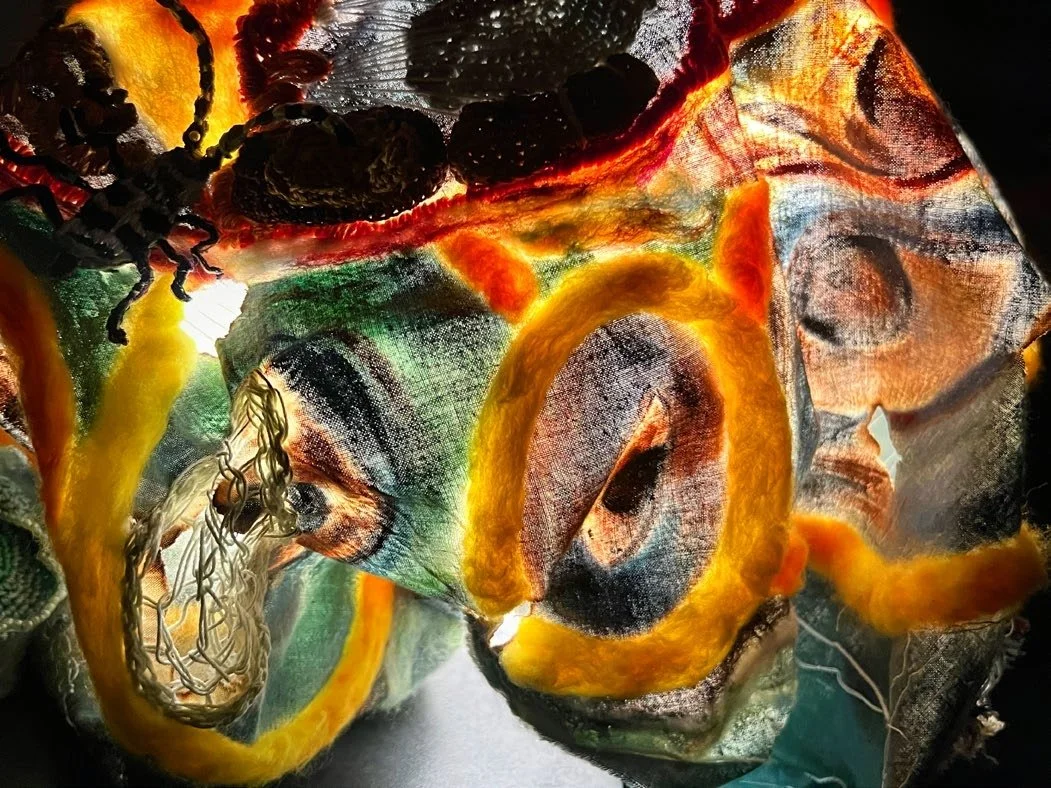
赵若希
Ruoxi Zhao
赵若希,毕业于大连大学的美术教育。作品大多都是关于社会现象的问题,她擅长从各种角度进行思考和尝试。美术教育这个专业让她学习到了很多绘画的方式和媒介,她擅长使用不同的材料结合绘画的形式去创作。她从纪录片,生活中的琐事以及书籍汲取灵感。
她来到这里学习是想尝试新鲜事物,体验不同的文化视角。她说在这里她可以脱离自己的舒适圈,自由的进行创作。
Zhao Ruoxi (Zoey) is a graduate of Art Education Dalian University (China). Through engaging with diverse mediums, and drawing inspiration from documentaries, literature and observations of everyday life, Ruoxi’s work reflects and questions social phenomena. Her art education background exposed her to numerous painting techniques and media, and she beautiful weaves various materials with painting forms in her creations.
Ruoxi came to Glasgow to study, experiment further with her art, and experience different cultural perspectives, with a desire to step out of her comfort zone and create freely.

作品感受
DAWN
我的母亲和祖母是我理解女性生存境遇的主要来源。她们在家庭中为琐事奔波的日常,让我直观感受到女性被“家庭责任、生育角色”这些社会枷锁束缚的状态。这种观察成为我作品的核心灵感,我不禁会思考,这样的生活真的是她们内心所愿吗?在我看来,有太多女性被“社会”这一无形的套子裹挟前行。
“My mother and grandmother are the main sources from which I understand the living conditions of women. Their daily hustle and bustle over trivial matters at home made me directly feel the state of women being bound by social shackles such as ‘family responsibilities and reproductive roles’. This observation has become the core inspiration for my works. I can't help but wonder: Is such a life really what they desire in their hearts? In my opinion, too many women are carried forward by the invisible trap of ‘society’.”
选择纤维材料,是因为它的物质性与隐喻性高度契合我的创作主题。一方面,纤维的“柔软与韧性”能直观表现“禁锢与挣脱”的张力——比如毛线的缠绕可象征社会期待对女性的捆绑,烧制后布料的破洞则隐喻枷锁的破碎;另一方面,纤维材料自带人文温度与历史感,我用童年被子的布料作为基底,让材料承载的家庭记忆与“女性在家庭中被规训”的主题形成呼应,同时,纤维的立体编织工艺(如串珠、钩织)能与平面
“I chose fibre materials because their materiality and metaphorical nature are highly consistent with my creative theme. On the one hand, the ‘softness’ and ‘toughness’ of fibres can directly represent the tension of ‘confinement and liberation’ - for instance, the entanglement of wool can symbolise the binding of women by social expectations, and the holes in the fabric after firing imply the breaking of shackles. On the other hand, fibre materials inherently carry a humanistic warmth and a sense of history. I used the fabric of my childhood quilt as the base, allowing the family memories carried by the material to echo the theme of ‘women being disciplined in the family’. Meanwhile, the three-dimensional weaving techniques of fibres (such as beading and crochet) can be combined with flat oil paintings to create a layered texture of organs and reproductive elements. Make the process of ‘breaking free from confinement’ more visually striking.”
我认为 是我最具自我突破的一个作品,因为在制作的过程中,我并不能完全确定结合光影之后的结果符合我的预期,这是我第一次尝试将多种材料混合并与光影结合创作。幸而结果是好的。
“I think Dawn is my most self-transcendent work. Because during the production process, I couldn't be completely sure that my visions of combining light and shadow would meet my expectations. This was my first attempt to mix multiple materials and combine them with light and shadow for creation. Fortunately, the result was good.”
食谱
RECIPE
歌词:
月儿明,风儿静,树叶遮窗棂,蛐蛐儿叫铮铮,好比那琴弦儿声。琴声儿轻,调儿动听,摇篮轻摆动,娘的宝宝,闭上眼睛,睡了那个睡在梦中。小鸽子你高高飞,咕咕它叫两声,小宝宝睡梦中微微他露了笑容,眉儿那个青,脸儿那个红,好像个小英雄。小英雄要去当兵,
为了祖国你立大功。露水儿洒花儿,窗前的花儿红,花儿开花儿红,宝宝你就要长成。
西红柿火腿粥
食材清单:
生米
生菜两片
火腿一根
鸡蛋一个
西红柿一个
东北民谣《摇篮曲》
northeastern folk song lullaby
tomato & ham Porridge
做法步骤:
大米提前泡半个小时,热水下生米,小火煮10到15分钟(需要搅拌)
加火腿+番茄煮3分钟
再加入鸡蛋煮熟,
出锅前加入生菜、生抽、盐、香油
Method and steps
Soak the rice for half an hour in advance. Add the raw rice to hot water and simmer over low heat for 10 to 15 minutes (stirring is necessary).
Add ham and tomatoes and cook for 3 minutes
Then add the eggs and cook until done.
Before serving, add lettuce, light soy sauce, salt and sesame oil
List of ingredients
100g raw rice
2 pieces of lettuce
One ham
Crack an egg
One tomato
歌
song
Lyrics:
The moon is bright, the wind is calm, leaves cover the window lattice, and crickets chirp loudly, just like the sound of strings on a lute. The music is soft and the tune is pleasant. The cradle is gently swaying. Mother's baby, close your eyes and fall asleep. That one is sleeping in a dream. Little pigeon, you fly high, cooing twice. The little baby, in his sleep, shows a slight smile. His eyebrows are so blue and his face so red, just like a little hero. The little hero is going to join the army.
You have made great contributions to our motherland. Dewdrops sprinkle on the flowers. The flowers by the window turn red. The flowers bloom and turn red. Baby, you are about to grow up.
材料含义
线(毛线、丝线等):隐喻社会规训的缠绕与生命的羁绊。它像编织的“罗网”,代表家庭责任、性别期待对女性的捆绑。
烧制的布料破洞:隐喻禁锢的破碎与自由的缝隙。破洞处的透光感,是女性挣脱家庭、生育枷锁后,自由与希望的具象化——如同破晓时的微光,从枷锁的裂缝中透现。
旧布料基底:隐喻个体在家庭与社会中的身份溯源。它承载着童年与家庭的记忆,却又被改造、重构,暗示女性在“家庭角色”的规训下,既被塑造又试图突破的身份挣扎。
纤维的编织肌理(串珠、毛毡堆叠):隐喻繁殖压力与社会期待的层层包裹。如同女性在家庭琐事、生育责任中被不断叠加的负担,纤维的厚重肌理让这种“压力的重量”变得可感知。
The meaning behind the materials:
“Thread (wool thread, silk thread, etc.) : It is a metaphor for the entanglement of social discipline and the bond of life. It is like a woven ‘net’, representing the constraints imposed on women by family responsibilities and gender expectations.
The holes in the fired fabric metaphorically represent the shattering of confinement and the cracks in freedom. The sense of light passing through the holes is a concrete manifestation of women's freedom and hope after breaking free from the shackles of family and childbirth - like the faint light at dawn, seeping through the cracks of the shackles.
The old fabric base metaphorically represents the origin of an individual's identity within the family and society. It carries the memories of childhood and family, yet is transformed and reconstructed, hinting at the identity struggle of women under the discipline of ‘family roles’, being both shaped and attempting to break through.
The practice of weaving these fibres metaphorically representing the layer-by-layer wrapping of reproductive pressure and social expectations. Just as women are constantly burdened with household chores and reproductive responsibilities, the thick texture of the fibres makes this ‘weight of pressure’ perceptible.”

